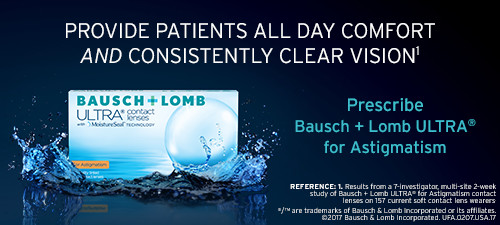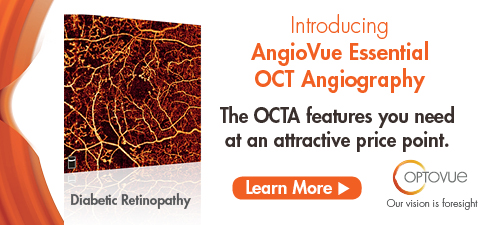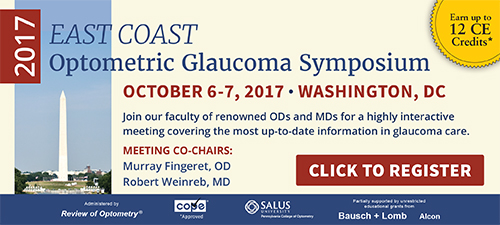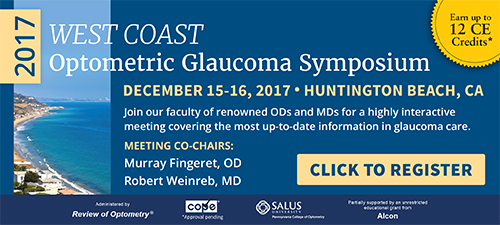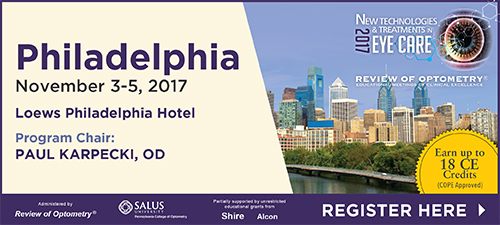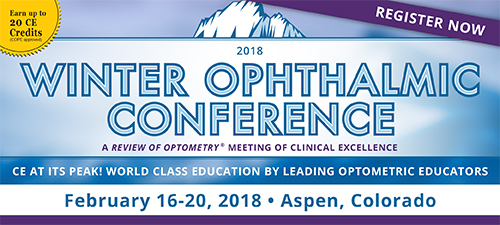
A
weekly e-journal by Art Epstein, OD, FAAO
Off the Cuff: Biting the Hands That Feed Them
In a country that leads the world in so many ways, too many people, including those in the middle class, lack adequate healthcare. Healthcare in the United States is sick, and it increasingly seems that a reasonable or intelligent cure is unlikely anytime soon. What does it say about Congress that late night talk show host Jimmy Kimmel has become one of the most rational voices in a sea of disingenuous legislative babble and doubletalk?
|
|||||
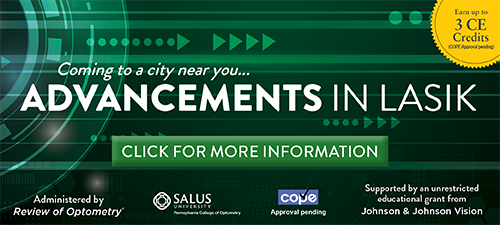 |
||
| Effect of Contact Lens Surface Properties on Comfort, Tear Stability and Ocular Physiology | ||||
Retrospective analysis of different contact lens wearing groups suggests lens surface lubricity is the main factor influencing contact lens comfort. However, in this study, the examined commercially available contact lenses differed in material and design as well as surface properties. Researchers isolated the contribution of lens surface properties using an ultra-thin coating technology. Nineteen habitual contact lens wearers (21.6 ± 1.7 years) wore formofilcon B soft monthly disposable contact lenses with and without coating technology modified surface properties for a month each in a randomized double-masked cross-over study. Breakup time (NIKBUT), NIKBUT average and ocular redness (Jenvis grading scale) were evaluated (Keratograph 5M) after one week and one month of wear. Symptoms were assessed using the Contact Lens Dry Eye Questionnaire (CLDEQ-8); perceived vision quality and subjective lens comfort at insertion, mid-day and end of the day were rated with four Visual Analog Scales.
Perceived visual quality, contact lens dry eye symptoms and subjective lens comfort were better for coated compared with uncoated lenses. The surface coating postponed the lens de-wetting and increased the pre-lens tear film stability, but bulbar and limbal redness were similar for both contact lenses. No parameter changed significantly between a weeks' and months' wear. Lens surface wettability and ocular redness were not correlated to changes in symptoms. Researchers wrote that, as previously hypothesized, enhancing the physical surface properties of a soft contact lens improved subjectively rated wearer comfort, which, in turn, was expected to result in reduced contact lens discontinuation. |
||||
SOURCE: Vidal-Rohr M, Wolffsohn JS, Davies LN, et al. Effect of contact lens surface properties on comfort, tear stability and ocular physiology. Cont Lens Anterior Eye. 2017; Sep 15. [Epub ahead of print]. |
||||
|
|||
| Refractive and Ocular Biometric Profile of Children with a History of Laser Treatment for Retinopathy of Prematurity | ||||
Indian children belong to a diverse socioeconomic strata with retinopathy of prematurity (ROP) developing in mature, higher birth weight babies as well, investigators wrote. The purpose of this study was to analyze the long-term status of refractive errors and its relationship with ocular biometry in children with ROP who were laser treated at a tertiary center in North India. Participants included children (<16 years) enrolled from January 2014 to December 2014 with a history of laser treatment for ROP examined for refractive and biometric status. Thirty-six children presenting at the mean age of 7.37 ± 3.07 years (6 to 15 years) were included. Mean spherical equivalent (SE) was -4.05D ± 5.10. Seventy-five percent were myopic, with high astigmatism in 31%. Higher lens thickness and higher SE at one year postnatal age were predictors of larger SE. A total of 79.4% achieved a favorable functional outcome (visual acuity ≥20/40), while 5.88% achieved unsatisfactory outcome (<20/200) despite having a favorable structural outcome. Investigators wrote that a substantial number of children developed myopia and high astigmatism while undergoing laser treatment for ROP. They found myopia in their cohort to be lenticular with greater axial length contributing to the development of high myopia. Investigators concluded that an initial large refractive error predicted future development of myopia in these children. Nearly 6% of patients with good structural outcomes had unexplained subnormal vision, so investigators suggested that the clinical threshold for prescribing glasses in this category of children should be low. |
||||
SOURCE: Kaur S, Sukhija J, Katoch D, et al. Refractive and ocular biometric profile of children with a history of laser treatment for retinopathy of prematurity. Indian J Ophthalmol; 2017;65(9):835-40. |
||||
|
|||
| Attention and Visual Motor Integration in Young Children with Uncorrected Hyperopia | ||||
Among four- and five-year-old children, deficits in measures of attention, visual-motor integration (VMI) and visual perception (VP) were associated with moderate, uncorrected hyperopia (3D to 6D) accompanied by reduced near visual function (near visual acuity worse than 20/40 or stereoacuity worse than 240 seconds of arc). This study compared attention, visual motor and visual perceptual skills in uncorrected hyperopes and emmetropes attending preschool or kindergarten, and evaluated associations with visual function. Participants were four and five years of age with either hyperopia (≥3D to ≤6D; astigmatism ≤1.5D; anisometropia ≤1D) or emmetropia (hyperopia ≤1D; astigmatism, anisometropia and myopia each <1D) without amblyopia or strabismus. Examiners masked to refractive status administered tests of attention (sustained, receptive and expressive), VMI and VP. Binocular visual acuity, stereoacuity and accommodative accuracy were also assessed at near. Analyses were adjusted for age, sex, race/ethnicity and parent's/caregiver's education.
Two hundred forty-four hyperopes (mean, +3.8D ± [SD] 0.8D) and 248 emmetropes (+0.5D ± 0.5D) completed testing. Results included that: the mean sustained attention score was worse in hyperopes compared with emmetropes; the mean receptive attention score was worse in 4D to 6D hyperopes compared with emmetropes; hyperopes with reduced near visual acuity (20/40 or worse) had worse scores than emmetropes; and hyperopes with stereoacuity of 240 seconds of arc or worse scored significantly worse than emmetropes. Overall, hyperopes with better near visual function generally performed similarly to emmetropes. Researchers found that moderately hyperopic children had deficits in measures of attention and that hyperopic children with reduced near visual function had lower scores on VMI and VP than emmetropic children. |
||||
SOURCE: Kulp MT, Ciner E, Maguire M, et al. Attention and visual motor integration in young children with uncorrected hyperopia. Optom Vis Sci. 2017; Sep 11. [Epub ahead of print]. |
||||
 |
||
| News & Notes | ||||||||
| Lacrivera Introduces Veraplug Flexfit Punctal Occluder The new FlexFit Punctal Occluder by Lacrivera now offers the FlexFit nose technology for dry eye practices, which is designed to collapse when inserted. As such, the device allows for ease of sizing and insertion, as well as excellent retention and patient comfort. The VeraPlug FlexFit offers four sizes in sterile preloaded and non-sterile bulk packaging. Read more.
|
||||||||
Johnson & Johnson Vision Acquires Sightbox, Expands Monthly Offering with
Acuvue Vita Brand Contact Lenses for Astigmatism
|
||||||||
| First Phase III Study Evaluating Spectri Fails to Meet Primary Endpoint Roche announced that the primary endpoint was not met in Spectri, the first of two Phase III studies evaluating the safety and efficacy of lampalizumab, an investigational medicine for the treatment of geographic atrophy due to age-related macular degeneration. Lampalizumab didn’t reduce mean change in GA lesion area compared with the sham treatment at one year (48 weeks). Given the lack of efficacy, further dosing in individuals will be interrupted until the results from the second Phase III study are evaluated, according to the company. Read more. |
||||||||
AAOF Selects Douglas W. Hopkins Primary Care Residency Award Recipient
|
||||||||
| AAOF Names Bert C. And Lydia M. Corwin Contact Lens Residency Award Recipient Jesus Gabriel Martinez, OD, cornea and contact lens fellow at the University of Houston, was chosen by a committee of members in the Cornea, Contact Lenses and Refractive Technologies Section of the American Academy of Optometry as this year’s recipient for the Bert C. & Lydia M. Corwin Residency Award. Dr. Martinez will receive a $2,000 education award and a $750 travel fellowship to attend Academy 2017. Read more.
|
||||||||
AAOF Releases Student Giving Match Program Recipients
|
||||||||
AAO & AAOF Name Student Travel Fellowship & Resident Travel Fellowship Recipients
|
||||||||
|
Optometric Physician™ (OP) newsletter is owned and published by Dr. Arthur Epstein. It is distributed by the Review Group, a Division of Jobson Medical Information LLC (JMI), 11 Campus Boulevard, Newtown Square, PA 19073. HOW TO ADVERTISE |




